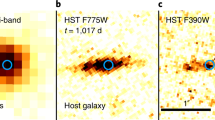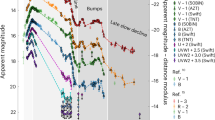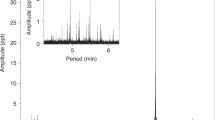Abstract
Supernova SN 2006gy in the galaxy NGC 1260 is the most luminous recorded1,2,3,4. Its progenitor might have been a very massive (>100 , where
, where  is the mass of the Sun) star5, but that interpretation is incompatible with hydrogen in the spectrum of the supernova; stars >40
is the mass of the Sun) star5, but that interpretation is incompatible with hydrogen in the spectrum of the supernova; stars >40 are believed to have shed their hydrogen envelopes several hundred thousand years before the explosion6. Alternatively, the progenitor might have arisen from the merger of two massive stars7. Here we show that the collision frequency of massive stars in a dense and young cluster (of the kind to be expected near the centre of a galaxy) is sufficient to provide a reasonable chance that SN 2006gy resulted from such a bombardment. If this is the correct explanation, then we predict that when the supernova fades (in a year or so) a dense cluster of massive stars will become visible at the site of the explosion.
are believed to have shed their hydrogen envelopes several hundred thousand years before the explosion6. Alternatively, the progenitor might have arisen from the merger of two massive stars7. Here we show that the collision frequency of massive stars in a dense and young cluster (of the kind to be expected near the centre of a galaxy) is sufficient to provide a reasonable chance that SN 2006gy resulted from such a bombardment. If this is the correct explanation, then we predict that when the supernova fades (in a year or so) a dense cluster of massive stars will become visible at the site of the explosion.
This is a preview of subscription content, access via your institution
Access options
Subscribe to this journal
Receive 51 print issues and online access
$199.00 per year
only $3.90 per issue
Buy this article
- Purchase on Springer Link
- Instant access to full article PDF
Prices may be subject to local taxes which are calculated during checkout

Similar content being viewed by others
References
Quimby, R. Supernova 2006gy in NGC 1260. Central Bureau Electron. Teleg. 644, 1 (2006)
Harutyunyan, A. et al. Supernova 2006gy in NGC 1260. Central Bureau Electron. Teleg. 647, 1 (2006)
Prieto, J. L., Garnavich, P., Chronister, A. & Connick, P. 2006gy in NGC 1260. Central Bureau Electron. Teleg. 648, 1 (2006)
Foley, R. J. et al. Supernova 2006gy in NGC 1260. Central Bureau Electron. Teleg. 695, 1 (2006)
Smith, N. et al. SN 2006gy: discovery of the most luminous supernova ever recorded, powered by the death of an extremely massive star like Eta Carinae. Preprint at 〈http://arxiv.org/astro-ph/0002483〉 (2006)
Meynet, G. & Maeder, A. Stellar evolution with rotation. XI. Wolf-Rayet star populations at different metallicities. Astron. Astrophys. 429, 581–598 (2005)
Ofek, E. O. et al. SN 2006gy: An extremely luminous supernova in the galaxy NGC 1260. Astrophys. J. Lett. 659, L13–L16 (2007)
Portegies Zwart, S. F., Makino, J., McMillan, S. L. W. & Hut, P. Star cluster ecology. III. Runaway collisions in young compact star clusters. Astron. Astrophys. 348, 117–126 (1999)
Suzuki, T. K. et al. Evolution of collisionally merged massive stars. Preprint at 〈http://arxiv.org/astro-ph/0703290〉 (2007)
Fryer, C. L. & Kalogera, V. Theoretical black hole mass distributions. Astrophys. J. 554, 548–560 (2001)
Portegies Zwart, S. F., Baumgardt, H., Hut, P., Makino, J. & McMillan, S. L. W. Formation of massive black holes through runaway collisions in dense young star clusters. Nature 428, 724–726 (2004)
Cotera, A. S. et al. The discovery of hot stars near the galactic center thermal radio filaments. Astrophys. J. 461, 750–761 (1996)
Cotera, A. S. et al. A new cluster of hot stars near the galactic center. Bull. Am. Astron. Soc. 1262–1263. (1992)
Dutra, C. M. & Bica, E. New star clusters projected close to the galactic centre. Astron. Astrophys. 359, L9–L12 (2000)
Dutra, C. M. et al. NTT infrared imaging of star cluster candidates towards the central parts of the Galaxy. Astron. Astrophys. 408, 127–134 (2003)
Maillard, J. P., Paumard, T., Stolovy, S. R. & Rigaut, F. The nature of the Galactic Center source IRS 13 revealed by high spatial resolution in the infrared. Astron. Astrophys. 423, 155–167 (2004)
Portegies Zwart, S. F. et al. The ecology of star clusters and intermediate-mass black holes in the Galactic Bulge. Astrophys. J. 641, 319–326 (2006)
Brunzendorf, J. & Meusinger, H. The galaxy cluster Abell 426 (Perseus). A catalogue of 660 galaxy positions, isophotal magnitudes and morphological types. Astron. Astrophys. (Suppl.) 139, 141–161 (1999)
Wegner, G. et al. Redshift-distance survey of early-type galaxies: spectroscopic data. Astron. J. 126, 2268–2280 (2003)
Salucci, P., Ashman, K. M. & Persic, M. The dark matter content of spiral galaxies. Astrophys. J. 379, 89–93 (1991)
Sanders, R. H. & Lowinger, T. The distribution of mass in the galactic nucleus. Astron. J. 77, 292–297 (1972)
Binney, J. & Tremaine, S. Galactic Dynamics 747 (Princeton Univ. Press, Princeton, New Jersey, 1987)
Portegies Zwart, S. F. & McMillan, S. L. W. The runaway growth of intermediate-mass black holes in dense star clusters. Astrophys. J. 576, 899–907 (2002)
Gürkan, M. A., Freitag, M. & Rasio, F. A. Formation of massive black holes in dense star clusters. I. Mass segregation and core collapse. Astrophys. J. 604, 632–652 (2004)
Freitag, M., Gürkan, M. A. & Rasio, F. A. Runaway collisions in young star clusters—II. Numerical results. Mon. Not. R. Astron. Soc. 368, 141–161 (2006)
King, I. R. The structure of star clusters. III. Some simple dynamical models. Astron. J. 71, 64–75 (1966)
Yungelson, L. R. Evolution of Ultra-Massive Stars and its Implications. Presented at 26th General Assembly of the IAU in Joint Discussion 5. “Calibrating the Top of the Stellar M-L Relation” (Prague, 2006)
Yungelson, L. R., van den Heuvel, E. P. J., Vink, J. S., Portegies Zwart, S. F. & de Koter, A. On the evolution and fate of supermassive stars. Astron. Astrophys. (in the press); preprint available at 〈http://arxiv.org/abs/0710.1181v1〉 (2007)
Lee, H. K., Wijers, R. A. M. J. & Brown, G. E. The Blandford-Znajek process as a central engine for a gamma-ray burst. Phys. Rep. 325, 83–114 (2000)
Leitherer, C. et al. Starburst99: synthesis models for galaxies with active star formation. Astrophys. J. (Suppl.) 123, 3–40 (1999)
Acknowledgements
This work was supported by the NWO, the Netherlands Research School for Astronomy (NOVA) and by a grant from the National Science Foundation to the Kavli Institute for Theoretical Physics in Santa Barbara.
Author information
Authors and Affiliations
Corresponding authors
Ethics declarations
Competing interests
The authors declare no competing financial interests.
Rights and permissions
About this article
Cite this article
Portegies Zwart, S., van den Heuvel, E. A runaway collision in a young star cluster as the origin of the brightest supernova. Nature 450, 388–389 (2007). https://doi.org/10.1038/nature06276
Received:
Accepted:
Published:
Issue Date:
DOI: https://doi.org/10.1038/nature06276
This article is cited by
-
A population of highly energetic transient events in the centres of active galaxies
Nature Astronomy (2017)
-
Path-length measurement performance evaluation of polarizing laser interferometer prototype
Applied Physics B (2015)
Comments
By submitting a comment you agree to abide by our Terms and Community Guidelines. If you find something abusive or that does not comply with our terms or guidelines please flag it as inappropriate.



